Emerging Technology and Innovations: Cloud ERP Implementation
VerifiedAdded on 2023/04/22
|5
|2682
|430
Report
AI Summary
This report delves into the implementation of cloud-based Enterprise Resource Planning (ERP) systems, analyzing their significance and impact on modern organizations. The study begins with an abstract summarizing the research approach and key findings, followed by an introduction that contextualizes the research and highlights its originality. A comprehensive literature review explores the current market of cloud-based ERP systems, examining various strategies and business models. The research then identifies a gap in existing literature, focusing on concerns related to data security and transparency within cloud environments. The report outlines the research's aims, including understanding cost implications, scalability, and disaster recovery. The methodology section details data collection, inclusion criteria, and analysis techniques. Results demonstrate the effectiveness of cloud technologies as an alternative to on-premise ERP solutions. The discussion section addresses challenges, such as data security, and suggests strategies for mitigating risks. The conclusion summarizes the advantages and disadvantages of cloud-based ERP implementation, emphasizing the need for stringent policies and employee training to ensure data security. The report includes references to support its findings.
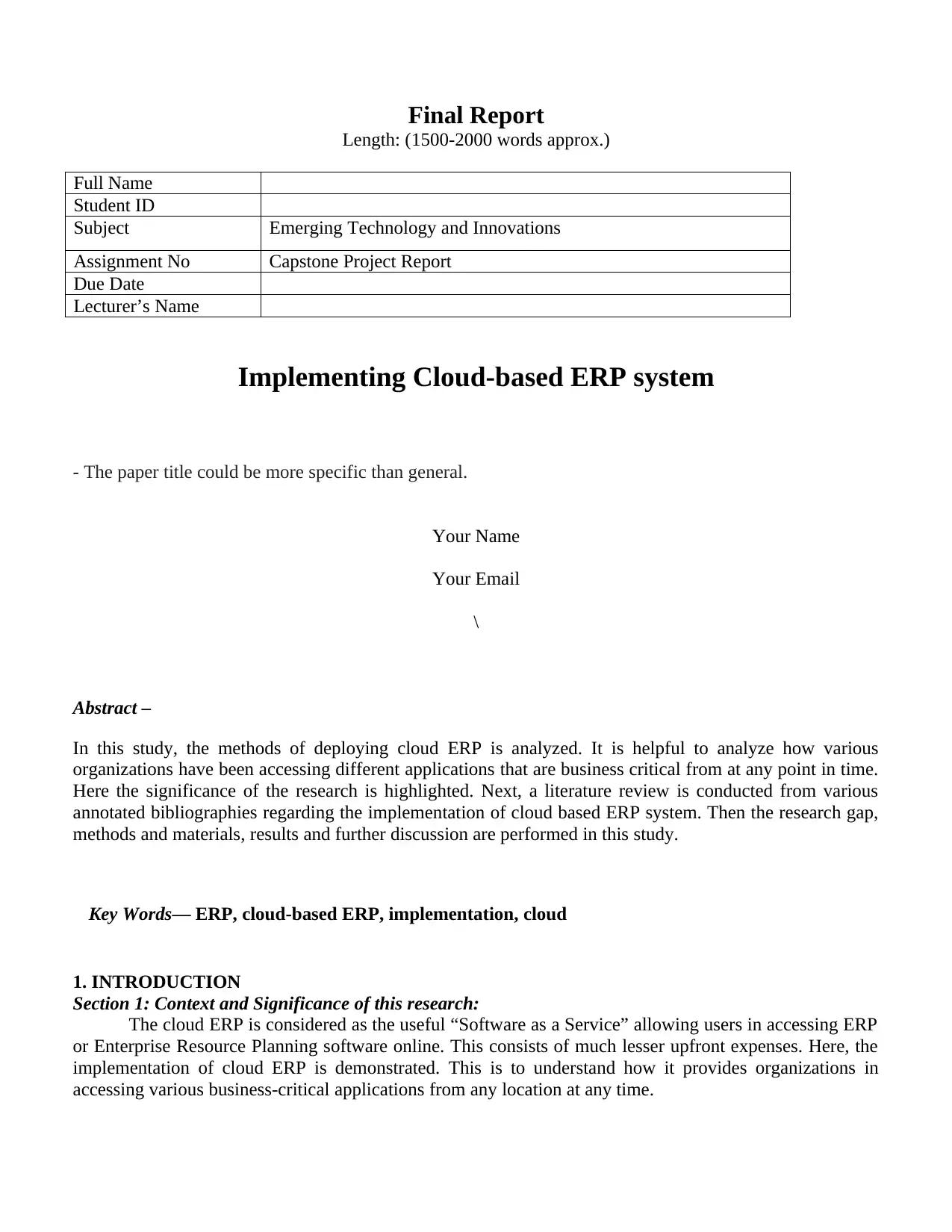
Final Report
Length: (1500-2000 words approx.)
Full Name
Student ID
Subject Emerging Technology and Innovations
Assignment No Capstone Project Report
Due Date
Lecturer’s Name
Implementing Cloud-based ERP system
- The paper title could be more specific than general.
Your Name
Your Email
\
Abstract –
In this study, the methods of deploying cloud ERP is analyzed. It is helpful to analyze how various
organizations have been accessing different applications that are business critical from at any point in time.
Here the significance of the research is highlighted. Next, a literature review is conducted from various
annotated bibliographies regarding the implementation of cloud based ERP system. Then the research gap,
methods and materials, results and further discussion are performed in this study.
Key Words— ERP, cloud-based ERP, implementation, cloud
1. INTRODUCTION
Section 1: Context and Significance of this research:
The cloud ERP is considered as the useful “Software as a Service” allowing users in accessing ERP
or Enterprise Resource Planning software online. This consists of much lesser upfront expenses. Here, the
implementation of cloud ERP is demonstrated. This is to understand how it provides organizations in
accessing various business-critical applications from any location at any time.
Length: (1500-2000 words approx.)
Full Name
Student ID
Subject Emerging Technology and Innovations
Assignment No Capstone Project Report
Due Date
Lecturer’s Name
Implementing Cloud-based ERP system
- The paper title could be more specific than general.
Your Name
Your Email
\
Abstract –
In this study, the methods of deploying cloud ERP is analyzed. It is helpful to analyze how various
organizations have been accessing different applications that are business critical from at any point in time.
Here the significance of the research is highlighted. Next, a literature review is conducted from various
annotated bibliographies regarding the implementation of cloud based ERP system. Then the research gap,
methods and materials, results and further discussion are performed in this study.
Key Words— ERP, cloud-based ERP, implementation, cloud
1. INTRODUCTION
Section 1: Context and Significance of this research:
The cloud ERP is considered as the useful “Software as a Service” allowing users in accessing ERP
or Enterprise Resource Planning software online. This consists of much lesser upfront expenses. Here, the
implementation of cloud ERP is demonstrated. This is to understand how it provides organizations in
accessing various business-critical applications from any location at any time.
Paraphrase This Document
Need a fresh take? Get an instant paraphrase of this document with our AI Paraphraser
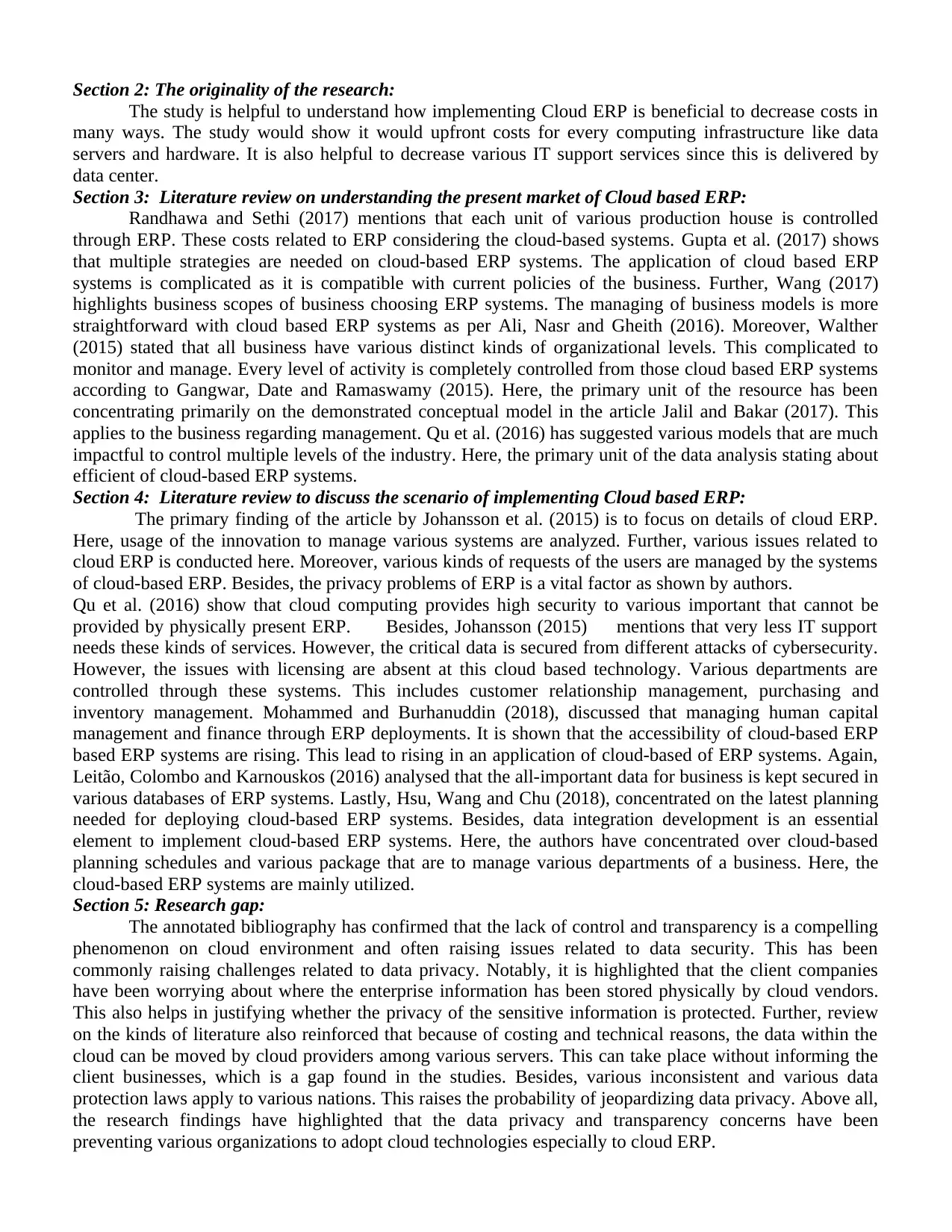
Section 2: The originality of the research:
The study is helpful to understand how implementing Cloud ERP is beneficial to decrease costs in
many ways. The study would show it would upfront costs for every computing infrastructure like data
servers and hardware. It is also helpful to decrease various IT support services since this is delivered by
data center.
Section 3: Literature review on understanding the present market of Cloud based ERP:
Randhawa and Sethi (2017) mentions that each unit of various production house is controlled
through ERP. These costs related to ERP considering the cloud-based systems. Gupta et al. (2017) shows
that multiple strategies are needed on cloud-based ERP systems. The application of cloud based ERP
systems is complicated as it is compatible with current policies of the business. Further, Wang (2017)
highlights business scopes of business choosing ERP systems. The managing of business models is more
straightforward with cloud based ERP systems as per Ali, Nasr and Gheith (2016). Moreover, Walther
(2015) stated that all business have various distinct kinds of organizational levels. This complicated to
monitor and manage. Every level of activity is completely controlled from those cloud based ERP systems
according to Gangwar, Date and Ramaswamy (2015). Here, the primary unit of the resource has been
concentrating primarily on the demonstrated conceptual model in the article Jalil and Bakar (2017). This
applies to the business regarding management. Qu et al. (2016) has suggested various models that are much
impactful to control multiple levels of the industry. Here, the primary unit of the data analysis stating about
efficient of cloud-based ERP systems.
Section 4: Literature review to discuss the scenario of implementing Cloud based ERP:
The primary finding of the article by Johansson et al. (2015) is to focus on details of cloud ERP.
Here, usage of the innovation to manage various systems are analyzed. Further, various issues related to
cloud ERP is conducted here. Moreover, various kinds of requests of the users are managed by the systems
of cloud-based ERP. Besides, the privacy problems of ERP is a vital factor as shown by authors.
Qu et al. (2016) show that cloud computing provides high security to various important that cannot be
provided by physically present ERP. Besides, Johansson (2015) mentions that very less IT support
needs these kinds of services. However, the critical data is secured from different attacks of cybersecurity.
However, the issues with licensing are absent at this cloud based technology. Various departments are
controlled through these systems. This includes customer relationship management, purchasing and
inventory management. Mohammed and Burhanuddin (2018), discussed that managing human capital
management and finance through ERP deployments. It is shown that the accessibility of cloud-based ERP
based ERP systems are rising. This lead to rising in an application of cloud-based of ERP systems. Again,
Leitão, Colombo and Karnouskos (2016) analysed that the all-important data for business is kept secured in
various databases of ERP systems. Lastly, Hsu, Wang and Chu (2018), concentrated on the latest planning
needed for deploying cloud-based ERP systems. Besides, data integration development is an essential
element to implement cloud-based ERP systems. Here, the authors have concentrated over cloud-based
planning schedules and various package that are to manage various departments of a business. Here, the
cloud-based ERP systems are mainly utilized.
Section 5: Research gap:
The annotated bibliography has confirmed that the lack of control and transparency is a compelling
phenomenon on cloud environment and often raising issues related to data security. This has been
commonly raising challenges related to data privacy. Notably, it is highlighted that the client companies
have been worrying about where the enterprise information has been stored physically by cloud vendors.
This also helps in justifying whether the privacy of the sensitive information is protected. Further, review
on the kinds of literature also reinforced that because of costing and technical reasons, the data within the
cloud can be moved by cloud providers among various servers. This can take place without informing the
client businesses, which is a gap found in the studies. Besides, various inconsistent and various data
protection laws apply to various nations. This raises the probability of jeopardizing data privacy. Above all,
the research findings have highlighted that the data privacy and transparency concerns have been
preventing various organizations to adopt cloud technologies especially to cloud ERP.
The study is helpful to understand how implementing Cloud ERP is beneficial to decrease costs in
many ways. The study would show it would upfront costs for every computing infrastructure like data
servers and hardware. It is also helpful to decrease various IT support services since this is delivered by
data center.
Section 3: Literature review on understanding the present market of Cloud based ERP:
Randhawa and Sethi (2017) mentions that each unit of various production house is controlled
through ERP. These costs related to ERP considering the cloud-based systems. Gupta et al. (2017) shows
that multiple strategies are needed on cloud-based ERP systems. The application of cloud based ERP
systems is complicated as it is compatible with current policies of the business. Further, Wang (2017)
highlights business scopes of business choosing ERP systems. The managing of business models is more
straightforward with cloud based ERP systems as per Ali, Nasr and Gheith (2016). Moreover, Walther
(2015) stated that all business have various distinct kinds of organizational levels. This complicated to
monitor and manage. Every level of activity is completely controlled from those cloud based ERP systems
according to Gangwar, Date and Ramaswamy (2015). Here, the primary unit of the resource has been
concentrating primarily on the demonstrated conceptual model in the article Jalil and Bakar (2017). This
applies to the business regarding management. Qu et al. (2016) has suggested various models that are much
impactful to control multiple levels of the industry. Here, the primary unit of the data analysis stating about
efficient of cloud-based ERP systems.
Section 4: Literature review to discuss the scenario of implementing Cloud based ERP:
The primary finding of the article by Johansson et al. (2015) is to focus on details of cloud ERP.
Here, usage of the innovation to manage various systems are analyzed. Further, various issues related to
cloud ERP is conducted here. Moreover, various kinds of requests of the users are managed by the systems
of cloud-based ERP. Besides, the privacy problems of ERP is a vital factor as shown by authors.
Qu et al. (2016) show that cloud computing provides high security to various important that cannot be
provided by physically present ERP. Besides, Johansson (2015) mentions that very less IT support
needs these kinds of services. However, the critical data is secured from different attacks of cybersecurity.
However, the issues with licensing are absent at this cloud based technology. Various departments are
controlled through these systems. This includes customer relationship management, purchasing and
inventory management. Mohammed and Burhanuddin (2018), discussed that managing human capital
management and finance through ERP deployments. It is shown that the accessibility of cloud-based ERP
based ERP systems are rising. This lead to rising in an application of cloud-based of ERP systems. Again,
Leitão, Colombo and Karnouskos (2016) analysed that the all-important data for business is kept secured in
various databases of ERP systems. Lastly, Hsu, Wang and Chu (2018), concentrated on the latest planning
needed for deploying cloud-based ERP systems. Besides, data integration development is an essential
element to implement cloud-based ERP systems. Here, the authors have concentrated over cloud-based
planning schedules and various package that are to manage various departments of a business. Here, the
cloud-based ERP systems are mainly utilized.
Section 5: Research gap:
The annotated bibliography has confirmed that the lack of control and transparency is a compelling
phenomenon on cloud environment and often raising issues related to data security. This has been
commonly raising challenges related to data privacy. Notably, it is highlighted that the client companies
have been worrying about where the enterprise information has been stored physically by cloud vendors.
This also helps in justifying whether the privacy of the sensitive information is protected. Further, review
on the kinds of literature also reinforced that because of costing and technical reasons, the data within the
cloud can be moved by cloud providers among various servers. This can take place without informing the
client businesses, which is a gap found in the studies. Besides, various inconsistent and various data
protection laws apply to various nations. This raises the probability of jeopardizing data privacy. Above all,
the research findings have highlighted that the data privacy and transparency concerns have been
preventing various organizations to adopt cloud technologies especially to cloud ERP.
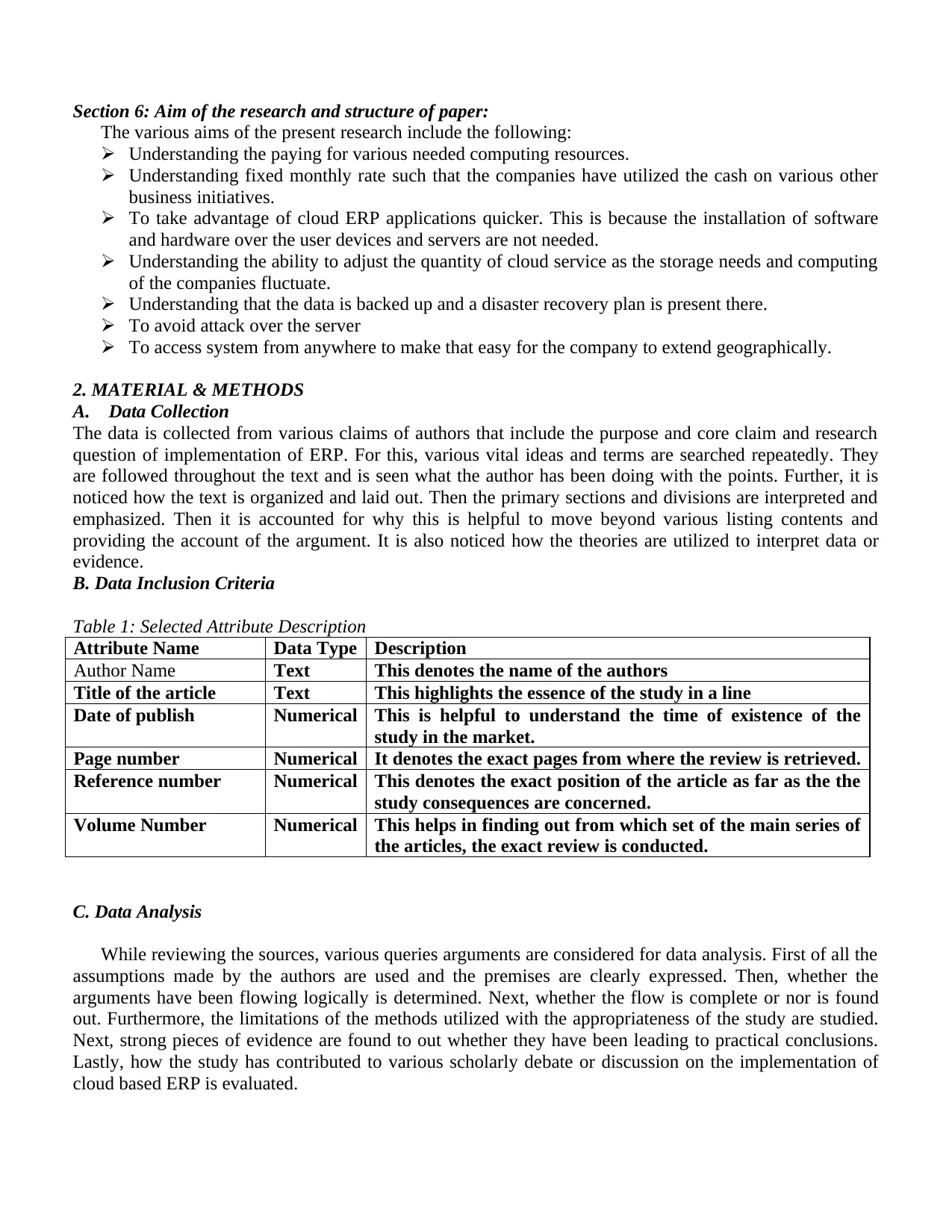
Section 6: Aim of the research and structure of paper:
The various aims of the present research include the following:
Understanding the paying for various needed computing resources.
Understanding fixed monthly rate such that the companies have utilized the cash on various other
business initiatives.
To take advantage of cloud ERP applications quicker. This is because the installation of software
and hardware over the user devices and servers are not needed.
Understanding the ability to adjust the quantity of cloud service as the storage needs and computing
of the companies fluctuate.
Understanding that the data is backed up and a disaster recovery plan is present there.
To avoid attack over the server
To access system from anywhere to make that easy for the company to extend geographically.
2. MATERIAL & METHODS
A. Data Collection
The data is collected from various claims of authors that include the purpose and core claim and research
question of implementation of ERP. For this, various vital ideas and terms are searched repeatedly. They
are followed throughout the text and is seen what the author has been doing with the points. Further, it is
noticed how the text is organized and laid out. Then the primary sections and divisions are interpreted and
emphasized. Then it is accounted for why this is helpful to move beyond various listing contents and
providing the account of the argument. It is also noticed how the theories are utilized to interpret data or
evidence.
B. Data Inclusion Criteria
Table 1: Selected Attribute Description
Attribute Name Data Type Description
Author Name Text This denotes the name of the authors
Title of the article Text This highlights the essence of the study in a line
Date of publish Numerical This is helpful to understand the time of existence of the
study in the market.
Page number Numerical It denotes the exact pages from where the review is retrieved.
Reference number Numerical This denotes the exact position of the article as far as the the
study consequences are concerned.
Volume Number Numerical This helps in finding out from which set of the main series of
the articles, the exact review is conducted.
C. Data Analysis
While reviewing the sources, various queries arguments are considered for data analysis. First of all the
assumptions made by the authors are used and the premises are clearly expressed. Then, whether the
arguments have been flowing logically is determined. Next, whether the flow is complete or nor is found
out. Furthermore, the limitations of the methods utilized with the appropriateness of the study are studied.
Next, strong pieces of evidence are found to out whether they have been leading to practical conclusions.
Lastly, how the study has contributed to various scholarly debate or discussion on the implementation of
cloud based ERP is evaluated.
The various aims of the present research include the following:
Understanding the paying for various needed computing resources.
Understanding fixed monthly rate such that the companies have utilized the cash on various other
business initiatives.
To take advantage of cloud ERP applications quicker. This is because the installation of software
and hardware over the user devices and servers are not needed.
Understanding the ability to adjust the quantity of cloud service as the storage needs and computing
of the companies fluctuate.
Understanding that the data is backed up and a disaster recovery plan is present there.
To avoid attack over the server
To access system from anywhere to make that easy for the company to extend geographically.
2. MATERIAL & METHODS
A. Data Collection
The data is collected from various claims of authors that include the purpose and core claim and research
question of implementation of ERP. For this, various vital ideas and terms are searched repeatedly. They
are followed throughout the text and is seen what the author has been doing with the points. Further, it is
noticed how the text is organized and laid out. Then the primary sections and divisions are interpreted and
emphasized. Then it is accounted for why this is helpful to move beyond various listing contents and
providing the account of the argument. It is also noticed how the theories are utilized to interpret data or
evidence.
B. Data Inclusion Criteria
Table 1: Selected Attribute Description
Attribute Name Data Type Description
Author Name Text This denotes the name of the authors
Title of the article Text This highlights the essence of the study in a line
Date of publish Numerical This is helpful to understand the time of existence of the
study in the market.
Page number Numerical It denotes the exact pages from where the review is retrieved.
Reference number Numerical This denotes the exact position of the article as far as the the
study consequences are concerned.
Volume Number Numerical This helps in finding out from which set of the main series of
the articles, the exact review is conducted.
C. Data Analysis
While reviewing the sources, various queries arguments are considered for data analysis. First of all the
assumptions made by the authors are used and the premises are clearly expressed. Then, whether the
arguments have been flowing logically is determined. Next, whether the flow is complete or nor is found
out. Furthermore, the limitations of the methods utilized with the appropriateness of the study are studied.
Next, strong pieces of evidence are found to out whether they have been leading to practical conclusions.
Lastly, how the study has contributed to various scholarly debate or discussion on the implementation of
cloud based ERP is evaluated.
⊘ This is a preview!⊘
Do you want full access?
Subscribe today to unlock all pages.

Trusted by 1+ million students worldwide
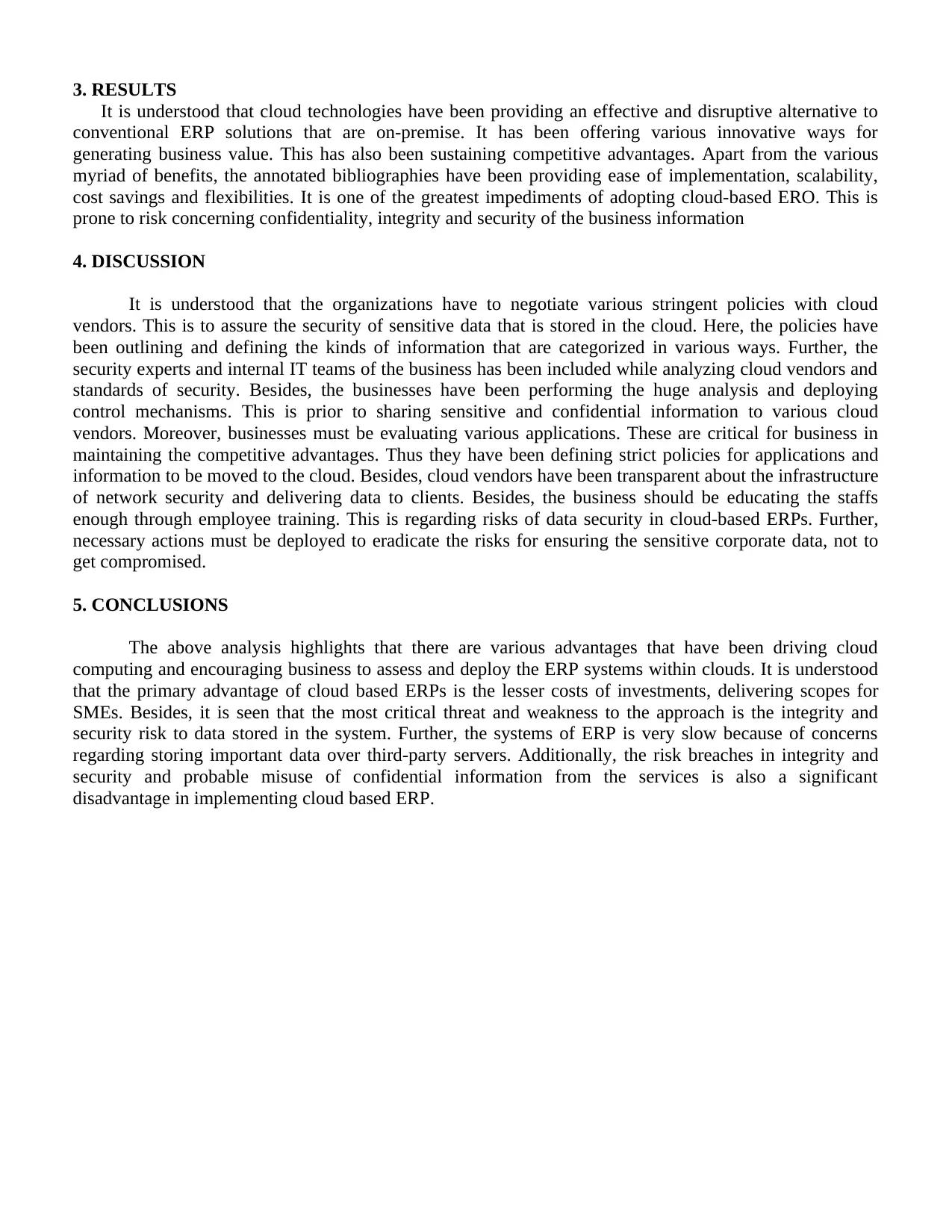
3. RESULTS
It is understood that cloud technologies have been providing an effective and disruptive alternative to
conventional ERP solutions that are on-premise. It has been offering various innovative ways for
generating business value. This has also been sustaining competitive advantages. Apart from the various
myriad of benefits, the annotated bibliographies have been providing ease of implementation, scalability,
cost savings and flexibilities. It is one of the greatest impediments of adopting cloud-based ERO. This is
prone to risk concerning confidentiality, integrity and security of the business information
4. DISCUSSION
It is understood that the organizations have to negotiate various stringent policies with cloud
vendors. This is to assure the security of sensitive data that is stored in the cloud. Here, the policies have
been outlining and defining the kinds of information that are categorized in various ways. Further, the
security experts and internal IT teams of the business has been included while analyzing cloud vendors and
standards of security. Besides, the businesses have been performing the huge analysis and deploying
control mechanisms. This is prior to sharing sensitive and confidential information to various cloud
vendors. Moreover, businesses must be evaluating various applications. These are critical for business in
maintaining the competitive advantages. Thus they have been defining strict policies for applications and
information to be moved to the cloud. Besides, cloud vendors have been transparent about the infrastructure
of network security and delivering data to clients. Besides, the business should be educating the staffs
enough through employee training. This is regarding risks of data security in cloud-based ERPs. Further,
necessary actions must be deployed to eradicate the risks for ensuring the sensitive corporate data, not to
get compromised.
5. CONCLUSIONS
The above analysis highlights that there are various advantages that have been driving cloud
computing and encouraging business to assess and deploy the ERP systems within clouds. It is understood
that the primary advantage of cloud based ERPs is the lesser costs of investments, delivering scopes for
SMEs. Besides, it is seen that the most critical threat and weakness to the approach is the integrity and
security risk to data stored in the system. Further, the systems of ERP is very slow because of concerns
regarding storing important data over third-party servers. Additionally, the risk breaches in integrity and
security and probable misuse of confidential information from the services is also a significant
disadvantage in implementing cloud based ERP.
It is understood that cloud technologies have been providing an effective and disruptive alternative to
conventional ERP solutions that are on-premise. It has been offering various innovative ways for
generating business value. This has also been sustaining competitive advantages. Apart from the various
myriad of benefits, the annotated bibliographies have been providing ease of implementation, scalability,
cost savings and flexibilities. It is one of the greatest impediments of adopting cloud-based ERO. This is
prone to risk concerning confidentiality, integrity and security of the business information
4. DISCUSSION
It is understood that the organizations have to negotiate various stringent policies with cloud
vendors. This is to assure the security of sensitive data that is stored in the cloud. Here, the policies have
been outlining and defining the kinds of information that are categorized in various ways. Further, the
security experts and internal IT teams of the business has been included while analyzing cloud vendors and
standards of security. Besides, the businesses have been performing the huge analysis and deploying
control mechanisms. This is prior to sharing sensitive and confidential information to various cloud
vendors. Moreover, businesses must be evaluating various applications. These are critical for business in
maintaining the competitive advantages. Thus they have been defining strict policies for applications and
information to be moved to the cloud. Besides, cloud vendors have been transparent about the infrastructure
of network security and delivering data to clients. Besides, the business should be educating the staffs
enough through employee training. This is regarding risks of data security in cloud-based ERPs. Further,
necessary actions must be deployed to eradicate the risks for ensuring the sensitive corporate data, not to
get compromised.
5. CONCLUSIONS
The above analysis highlights that there are various advantages that have been driving cloud
computing and encouraging business to assess and deploy the ERP systems within clouds. It is understood
that the primary advantage of cloud based ERPs is the lesser costs of investments, delivering scopes for
SMEs. Besides, it is seen that the most critical threat and weakness to the approach is the integrity and
security risk to data stored in the system. Further, the systems of ERP is very slow because of concerns
regarding storing important data over third-party servers. Additionally, the risk breaches in integrity and
security and probable misuse of confidential information from the services is also a significant
disadvantage in implementing cloud based ERP.
Paraphrase This Document
Need a fresh take? Get an instant paraphrase of this document with our AI Paraphraser
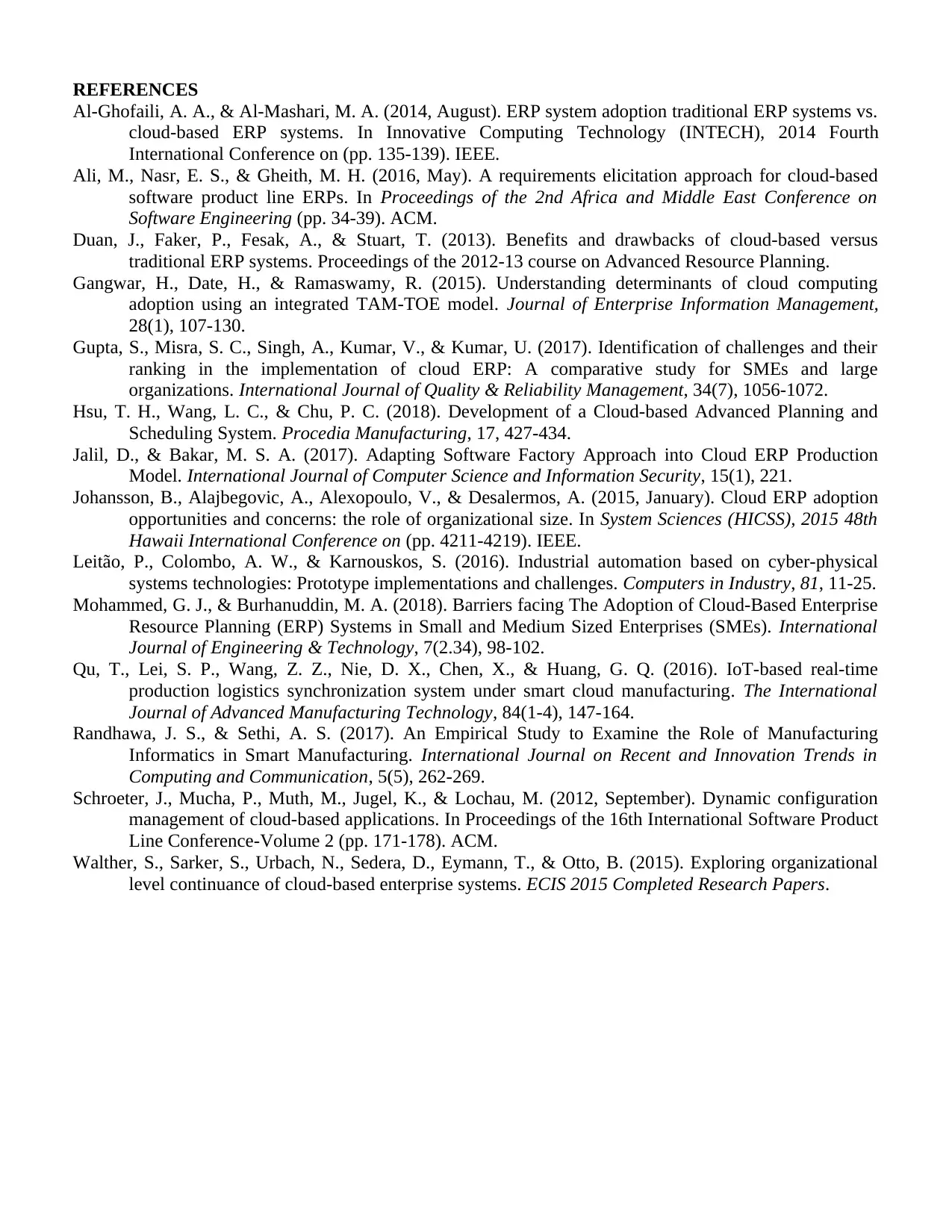
REFERENCES
Al-Ghofaili, A. A., & Al-Mashari, M. A. (2014, August). ERP system adoption traditional ERP systems vs.
cloud-based ERP systems. In Innovative Computing Technology (INTECH), 2014 Fourth
International Conference on (pp. 135-139). IEEE.
Ali, M., Nasr, E. S., & Gheith, M. H. (2016, May). A requirements elicitation approach for cloud-based
software product line ERPs. In Proceedings of the 2nd Africa and Middle East Conference on
Software Engineering (pp. 34-39). ACM.
Duan, J., Faker, P., Fesak, A., & Stuart, T. (2013). Benefits and drawbacks of cloud-based versus
traditional ERP systems. Proceedings of the 2012-13 course on Advanced Resource Planning.
Gangwar, H., Date, H., & Ramaswamy, R. (2015). Understanding determinants of cloud computing
adoption using an integrated TAM-TOE model. Journal of Enterprise Information Management,
28(1), 107-130.
Gupta, S., Misra, S. C., Singh, A., Kumar, V., & Kumar, U. (2017). Identification of challenges and their
ranking in the implementation of cloud ERP: A comparative study for SMEs and large
organizations. International Journal of Quality & Reliability Management, 34(7), 1056-1072.
Hsu, T. H., Wang, L. C., & Chu, P. C. (2018). Development of a Cloud-based Advanced Planning and
Scheduling System. Procedia Manufacturing, 17, 427-434.
Jalil, D., & Bakar, M. S. A. (2017). Adapting Software Factory Approach into Cloud ERP Production
Model. International Journal of Computer Science and Information Security, 15(1), 221.
Johansson, B., Alajbegovic, A., Alexopoulo, V., & Desalermos, A. (2015, January). Cloud ERP adoption
opportunities and concerns: the role of organizational size. In System Sciences (HICSS), 2015 48th
Hawaii International Conference on (pp. 4211-4219). IEEE.
Leitão, P., Colombo, A. W., & Karnouskos, S. (2016). Industrial automation based on cyber-physical
systems technologies: Prototype implementations and challenges. Computers in Industry, 81, 11-25.
Mohammed, G. J., & Burhanuddin, M. A. (2018). Barriers facing The Adoption of Cloud-Based Enterprise
Resource Planning (ERP) Systems in Small and Medium Sized Enterprises (SMEs). International
Journal of Engineering & Technology, 7(2.34), 98-102.
Qu, T., Lei, S. P., Wang, Z. Z., Nie, D. X., Chen, X., & Huang, G. Q. (2016). IoT-based real-time
production logistics synchronization system under smart cloud manufacturing. The International
Journal of Advanced Manufacturing Technology, 84(1-4), 147-164.
Randhawa, J. S., & Sethi, A. S. (2017). An Empirical Study to Examine the Role of Manufacturing
Informatics in Smart Manufacturing. International Journal on Recent and Innovation Trends in
Computing and Communication, 5(5), 262-269.
Schroeter, J., Mucha, P., Muth, M., Jugel, K., & Lochau, M. (2012, September). Dynamic configuration
management of cloud-based applications. In Proceedings of the 16th International Software Product
Line Conference-Volume 2 (pp. 171-178). ACM.
Walther, S., Sarker, S., Urbach, N., Sedera, D., Eymann, T., & Otto, B. (2015). Exploring organizational
level continuance of cloud-based enterprise systems. ECIS 2015 Completed Research Papers.
Al-Ghofaili, A. A., & Al-Mashari, M. A. (2014, August). ERP system adoption traditional ERP systems vs.
cloud-based ERP systems. In Innovative Computing Technology (INTECH), 2014 Fourth
International Conference on (pp. 135-139). IEEE.
Ali, M., Nasr, E. S., & Gheith, M. H. (2016, May). A requirements elicitation approach for cloud-based
software product line ERPs. In Proceedings of the 2nd Africa and Middle East Conference on
Software Engineering (pp. 34-39). ACM.
Duan, J., Faker, P., Fesak, A., & Stuart, T. (2013). Benefits and drawbacks of cloud-based versus
traditional ERP systems. Proceedings of the 2012-13 course on Advanced Resource Planning.
Gangwar, H., Date, H., & Ramaswamy, R. (2015). Understanding determinants of cloud computing
adoption using an integrated TAM-TOE model. Journal of Enterprise Information Management,
28(1), 107-130.
Gupta, S., Misra, S. C., Singh, A., Kumar, V., & Kumar, U. (2017). Identification of challenges and their
ranking in the implementation of cloud ERP: A comparative study for SMEs and large
organizations. International Journal of Quality & Reliability Management, 34(7), 1056-1072.
Hsu, T. H., Wang, L. C., & Chu, P. C. (2018). Development of a Cloud-based Advanced Planning and
Scheduling System. Procedia Manufacturing, 17, 427-434.
Jalil, D., & Bakar, M. S. A. (2017). Adapting Software Factory Approach into Cloud ERP Production
Model. International Journal of Computer Science and Information Security, 15(1), 221.
Johansson, B., Alajbegovic, A., Alexopoulo, V., & Desalermos, A. (2015, January). Cloud ERP adoption
opportunities and concerns: the role of organizational size. In System Sciences (HICSS), 2015 48th
Hawaii International Conference on (pp. 4211-4219). IEEE.
Leitão, P., Colombo, A. W., & Karnouskos, S. (2016). Industrial automation based on cyber-physical
systems technologies: Prototype implementations and challenges. Computers in Industry, 81, 11-25.
Mohammed, G. J., & Burhanuddin, M. A. (2018). Barriers facing The Adoption of Cloud-Based Enterprise
Resource Planning (ERP) Systems in Small and Medium Sized Enterprises (SMEs). International
Journal of Engineering & Technology, 7(2.34), 98-102.
Qu, T., Lei, S. P., Wang, Z. Z., Nie, D. X., Chen, X., & Huang, G. Q. (2016). IoT-based real-time
production logistics synchronization system under smart cloud manufacturing. The International
Journal of Advanced Manufacturing Technology, 84(1-4), 147-164.
Randhawa, J. S., & Sethi, A. S. (2017). An Empirical Study to Examine the Role of Manufacturing
Informatics in Smart Manufacturing. International Journal on Recent and Innovation Trends in
Computing and Communication, 5(5), 262-269.
Schroeter, J., Mucha, P., Muth, M., Jugel, K., & Lochau, M. (2012, September). Dynamic configuration
management of cloud-based applications. In Proceedings of the 16th International Software Product
Line Conference-Volume 2 (pp. 171-178). ACM.
Walther, S., Sarker, S., Urbach, N., Sedera, D., Eymann, T., & Otto, B. (2015). Exploring organizational
level continuance of cloud-based enterprise systems. ECIS 2015 Completed Research Papers.
1 out of 5
Related Documents
Your All-in-One AI-Powered Toolkit for Academic Success.
+13062052269
info@desklib.com
Available 24*7 on WhatsApp / Email
![[object Object]](/_next/static/media/star-bottom.7253800d.svg)
Unlock your academic potential
Copyright © 2020–2025 A2Z Services. All Rights Reserved. Developed and managed by ZUCOL.





